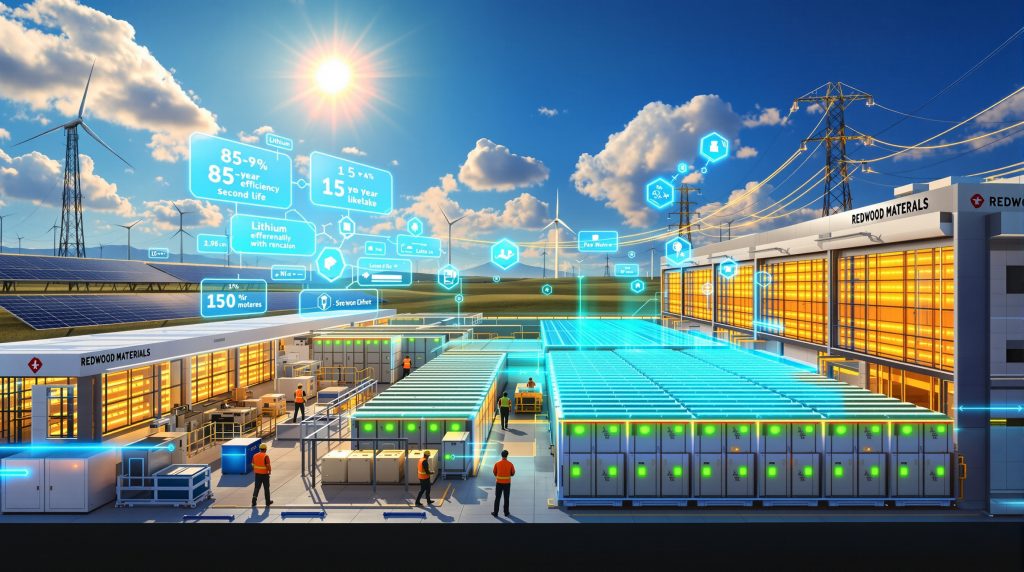What Makes Redwood Materials Second-Life Battery Storage Revolutionary?
The energy storage landscape is experiencing a fundamental transformation as companies like Redwood Materials pioneer innovative approaches to extending battery lifecycles. Rather than immediately recycling electric vehicle batteries that have reached the end of their automotive service, Redwood Materials second-life battery storage technology captures additional value by repurposing these batteries for stationary energy applications. This innovative approach follows a recent battery recycling breakthrough that has revolutionised industry practices worldwide.
Defining Second-Life Battery Technology
Second-life battery storage represents a critical bridge between automotive applications and material recovery. When electric vehicle batteries can no longer meet the demanding power and range requirements of transportation, they typically retain 50-80% of their original capacity. This remaining energy storage capability makes them highly suitable for grid-scale applications where weight and space constraints are less restrictive.
The assessment process involves rigorous capacity testing and safety verification procedures to determine which batteries qualify for extended service. Battery packs undergo comprehensive state-of-health evaluations, including voltage cycling, impedance testing, and thermal performance analysis. Those meeting specific criteria advance to second-life deployment, while others proceed directly to recycling for critical mineral recovery.
Key technical criteria for second-life suitability include:
• Capacity retention above 70% of original specifications
• Structural integrity of cell housings and connections
• Thermal stability within operating temperature ranges
• Safety compliance with stationary storage standards
The Circular Economy Advantage
Redwood Materials has positioned itself as a market leader by creating an integrated circular economy model that maximises value extraction from every battery. Rather than focusing solely on critical materials recovery like cobalt, nickel, copper, lithium, and cathode materials, the company now incorporates grid energy storage as a core business area. Furthermore, this approach aligns with broader mining decarbonisation trends shaping the industry's sustainable future.
This approach delivers significant economic benefits by extending battery lifecycles before material recovery. Industry analysis suggests that second-life deployments can reduce energy storage costs by 30-50% compared to new battery systems while extending useful battery life by 5-10 years. These cost advantages stem from avoided manufacturing expenses and reduced raw material demand.
Environmental impact reduction occurs through resource optimisation across multiple dimensions:
• Lower carbon footprint compared to new battery production
• Reduced mining pressure for critical minerals
• Extended material utilisation before recycling
• Decreased waste generation in the near term
The business model innovation becomes particularly compelling when considering supply chain disruptions. As CEO JB Straubel noted, this represents a pivotal time as curtailment in international supplies overlaps with intense domestic demand growth for these materials and energy products. This challenge directly impacts the broader battery metals landscape and its investment dynamics.
How Does Redwood's Second-Life Battery Storage Process Work?
Redwood Materials second-life battery storage operations integrate seamlessly with the company's existing recycling infrastructure. The process begins with systematic collection from automotive partners, most notably through a memorandum of understanding signed with General Motors in July 2025. This partnership provides access to both new GM batteries manufactured domestically and end-of-life battery packs from GM electric vehicles.
Battery Collection and Assessment Protocol
The collection network leverages Redwood's established position as the market leader in battery recycling in North America. The company has developed comprehensive structures to collect production rejects and used batteries from partners, including GM's battery joint venture, Ultium Cells. Additionally, this network benefits from innovations in battery recycling facility technologies that streamline collection processes.
A critical insight emerges from this collection process: many batteries arriving through the Redwood system remain in good condition, too good to be recycled directly. This observation led to the creation of Redwood Energy, a subsidiary launched in June 2025 specifically focused on second-life battery storage applications.
The assessment protocol involves multiple evaluation stages:
- Initial visual inspection for physical damage or leakage
- Capacity testing under controlled conditions
- Safety verification including thermal and electrical stability
- Quality grading to determine optimal deployment scenarios
System Integration and Deployment
Redwood's approach accommodates mixed battery chemistries through modular system designs. The first commercial deployment demonstrates this flexibility through a 12 MW power output and 63 MWh energy capacity facility constructed in Nevada. This installation serves a modular data centre operated by Crusoe Energy, an AI infrastructure company requiring reliable backup power and grid stabilisation services.
The Nevada facility utilises battery packs sourced from GM vehicles, showcasing the practical implementation of the dual-source strategy. The system integrates both second-life EV batteries and new batteries within the same installation, delivering fast and flexible power solutions for mission-critical applications.
System architecture considerations include:
• Modular configurations supporting diverse power and energy requirements
• Mixed-chemistry compatibility across different EV battery types
• Grid interconnection standards ensuring utility-scale compatibility
• Automated monitoring systems for performance optimisation
End-of-Life Transition to Recycling
The integrated circular economy model ensures seamless transitions from storage applications to material recovery. When second-life batteries reach the end of their useful service in stationary applications, they enter Redwood's established recycling processes for critical mineral extraction. This closed-loop approach maximises resource utilisation while minimising waste generation, contributing to the broader critical minerals transition towards sustainable mining practices.
The transition process involves systematic capacity monitoring throughout the storage deployment phase. Advanced battery management systems track performance degradation patterns, enabling proactive planning for recycling transitions. This data-driven approach optimises both storage revenue and recycling efficiency.
What Are the Key Performance Metrics of Redwood's Storage Systems?
Performance validation for Redwood Materials second-life battery storage systems relies primarily on the Nevada deployment with Crusoe Energy, which serves as a proof-of-concept for larger-scale applications. The 12 MW / 63 MWh configuration demonstrates technical feasibility while providing operational data for future system optimisations.
Real-World Deployment Statistics
The Nevada microgrid represents the first commercial application of Redwood's integrated approach, combining GM end-of-life battery packs with new batteries in a single installation. This facility supports AI infrastructure operations, where power reliability and rapid response capabilities are critical for maintaining computational workloads.
| Performance Indicator | Nevada Facility | Typical Range |
|---|---|---|
| Power Output | 12 MW | 1-50 MW per installation |
| Energy Capacity | 63 MWh | 5-300 MWh configurations |
| Application Focus | AI data centre backup | Multiple grid services |
| Battery Source | GM vehicle packs | Mixed OEM sources |
| Operational Status | Active since June 2025 | Expanding deployment |
The facility design accommodates the unique power demand characteristics of AI infrastructure, which experience unprecedented electricity demand growth. These applications require fast, flexible power solutions capable of supporting both planned and unplanned power events while maintaining grid stability.
System Scalability Demonstrations
Modular system architecture enables configurations ranging from 1-50 MW per installation, with energy capacities scaling from 5-300 MWh depending on application requirements. This flexibility addresses diverse market segments from industrial facilities to utility-scale grid services.
Response time capabilities position second-life battery storage competitively against traditional generation sources. Battery systems typically achieve sub-second response times for grid services, significantly faster than combustion turbines or other conventional power sources. This rapid response capability proves particularly valuable for frequency regulation and voltage support applications.
Efficiency rates for second-life systems generally achieve 85-92% round-trip efficiency, comparable to new battery installations. While some capacity degradation occurs compared to new systems, the cost advantages often justify slightly reduced efficiency metrics for many applications.
Which Industries Benefit Most from Second-Life Battery Storage?
The strategic pivot toward AI infrastructure represents a significant shift in Redwood Materials second-life battery storage market positioning. While renewable energy integration and industrial electrification remain important applications, AI data centres have emerged as the primary growth driver for second-life deployments.
AI Data Centres and High-Performance Computing
Electricity demand acceleration driven by AI and rapid electrification of transportation and industry creates unprecedented opportunities for energy storage deployment. The availability of electrical energy has become a key strategic factor for AI infrastructure growth, particularly as traditional power generation struggles to meet demand spikes. Moreover, companies like Redwood Materials are specifically targeting these high-demand sectors with innovative storage solutions.
AI data centres present unique power demand characteristics:
• High baseline power consumption with significant peak demands
• Critical reliability requirements due to computational workload sensitivity
• Rapid response needs for power quality maintenance
• Grid stabilisation services to support local electrical infrastructure
The Crusoe Energy partnership demonstrates practical implementation of these concepts. The 12 MW / 63 MWh Nevada facility provides backup power, peak demand management, and grid stabilisation services for modular AI data centre operations. This deployment validates technical performance while establishing operational precedents for future expansions.
Renewable Energy Integration
Beyond powering data centres, second-life battery storage capacity benefits industrial electrification and addresses intermittency challenges in domestic renewable generation. The storage systems complement natural gas turbines and future nuclear generation by dramatically improving efficiency, utilisation, and reliability of baseload assets.
Renewable integration applications include:
• Solar and wind intermittency management through energy time-shifting
• Peak shaving capabilities reducing demand charges for industrial customers
• Grid stabilisation services supporting increased renewable penetration
• Curtailment reduction capturing otherwise wasted renewable energy
Industrial Electrification Support
Manufacturing facilities increasingly require reliable backup power as electrification expands across industrial processes. Second-life battery storage provides cost-effective solutions for power quality improvement, emergency backup, and demand management applications.
Industrial applications benefit from:
- Manufacturing facility power quality improvements during grid disturbances
- Electric vehicle charging infrastructure backup for fleet operations
- Emergency power systems for critical production processes
- Load balancing capabilities reducing peak demand costs
How Does Redwood's Approach Compare to Competitors?
The competitive landscape reveals distinct strategic approaches across major players. Redwood's integrated model contrasts sharply with competitors focusing exclusively on either storage deployment or battery manufacturing. However, its positioning leverages the company's established market leadership in battery recycling across North America while expanding into adjacent value streams.
Market Positioning Analysis
The competitive landscape reveals distinct strategic approaches across major players. Redwood's integrated model contrasts sharply with competitors focusing exclusively on either storage deployment or battery manufacturing.
| Company | Primary Focus | Key Differentiator | Market Position |
|---|---|---|---|
| Redwood Materials | Integrated recycling + storage | Circular economy model | Market leader in NA recycling |
| B2U Storage Solutions | Pure second-life deployment | Specialised deployment focus | Smaller scale operations |
| Tesla Energy | New battery storage | Vertical integration | Global scale deployment |
| Fluence | Grid-scale storage | Technology agnostic | International deployment |
Competitive Advantages
Redwood's competitive positioning stems from exclusive access to high-volume EV battery streams through established OEM partnerships. The company has developed necessary collection structures for both production rejects and end-of-life batteries from partners, creating sustainable supply chain advantages.
The General Motors partnership exemplifies this strategic approach. The memorandum of understanding signed in July 2025 provides access to both Ultium Cells production output and GM vehicle end-of-life battery packs. This dual-source model ensures consistent battery supply across varying market conditions.
Strategic advantages include:
• Established collection infrastructure across North America
• Quality assessment capabilities optimising battery allocation between storage and recycling
• Integrated cost structure reducing end-of-life disposal expenses
• Regulatory compliance expertise from existing recycling operations
Supply Chain Integration Benefits
The circular economy approach provides cost advantages unavailable to pure-play competitors. Many batteries collected through Redwood's system remain too good to be recycled directly, creating opportunities for value-added storage applications before eventual material recovery. Industry analysts note that this approach has gained significant traction following reports that second-life EV batteries can work effectively in grid applications.
This integration delivers financial benefits through:
- Extended revenue generation from each battery through multiple lifecycle phases
- Reduced raw material costs for storage system development
- Minimised transportation expenses through consolidated collection networks
- Enhanced recycling economics through optimised material recovery timing
What Investment Opportunities Exist in Second-Life Battery Storage?
Investment interest in second-life battery storage reflects broader recognition of energy storage market opportunities. The company's recent funding success demonstrates investor confidence in integrated circular economy approaches to battery lifecycle management.
Recent Funding and Valuation Trends
Redwood Materials completed a Series E financing round worth $350 million in October 2025, with Eclipse serving as the lead investor. The funding round attracted new strategic investors, most notably NVentures, the venture capital arm of Nvidia, signalling recognition of energy storage connections to AI infrastructure development.
Funding details include:
• Total raised: $350 million Series E
• Lead investor: Eclipse
• Strategic participant: NVentures (Nvidia VC arm)
• Primary use: Second-life storage facility expansion and refinery development
• Market focus: American energy leadership and critical mineral independence
The investment aligns with management's vision of helping shape the next era of American energy leadership while addressing critical mineral supply chain vulnerabilities. As traditional EV market growth faces political headwinds, energy storage applications provide alternative growth pathways for battery recycling companies.
Market Growth Projections
The second-life battery storage market benefits from converging trends in EV adoption, renewable energy deployment, and AI infrastructure expansion. While specific market size projections vary, the fundamental drivers suggest substantial growth potential through 2030.
Key growth factors include:
• Increasing EV battery retirement volumes as early electric vehicles age
• Cost pressures driving demand for lower-cost storage alternatives
• AI infrastructure expansion requiring reliable backup power solutions
• Grid modernisation initiatives supporting distributed energy resources
Revenue diversification beyond traditional recycling creates multiple value streams from each battery asset. This model potentially extends total revenue per battery while reducing dependence on volatile critical mineral pricing.
Risk Assessment Framework
Investment considerations for second-life battery storage include both technology and market risks that require careful evaluation. While the circular economy model offers advantages, several factors could impact long-term viability.
Technology risks include:
- Battery degradation uncertainty affecting storage system performance over time
- Chemistry compatibility challenges as EV battery technologies evolve
- Safety protocol requirements potentially increasing operational complexity
- Grid integration standards changing regulatory compliance costs
Market risks encompass:
• Regulatory changes affecting recycling requirements or energy storage incentives
• Competition from new battery technologies reducing second-life value propositions
• Supply chain disruptions impacting battery collection volumes
• Economic cycles affecting data centre and industrial electricity demand
What Are the Technical Challenges and Solutions?
Implementing second-life battery storage systems requires addressing complex technical challenges spanning battery degradation management, grid integration, and safety protocols. These considerations become more complex when dealing with mixed-chemistry installations using batteries from different vehicle manufacturers and model years.
Battery Degradation Management
State-of-health monitoring systems play critical roles in optimising second-life battery performance and predicting maintenance requirements. Advanced analytics track capacity degradation patterns, thermal characteristics, and impedance changes throughout storage deployment phases.
Key monitoring parameters include:
• Capacity retention rates measured through periodic cycling tests
• Internal resistance changes indicating cell degradation progression
• Thermal performance variations affecting safety and efficiency
• Voltage balancing requirements across series-connected cell groups
Predictive analytics enable proactive maintenance scheduling and optimal battery retirement timing. These systems determine when storage batteries should transition to recycling applications, maximising both storage revenue and material recovery value.
Grid Integration Complexities
Utility-scale energy storage installations must comply with interconnection standards including IEEE 1547 for distributed energy resources and UL 9540 for safety requirements. These standards address power quality, harmonic distortion, and safety disconnection protocols.
Technical integration challenges include:
- Power quality maintenance ensuring voltage and frequency stability
- Harmonic distortion control preventing grid interference
- Cybersecurity protocols protecting distributed energy resources from attacks
- Interconnection approval processes varying by utility and jurisdiction
The Nevada facility with Crusoe Energy demonstrates successful grid integration for AI infrastructure applications. This deployment validates technical approaches while providing operational data for future installations.
Scalability and Standardisation
Modular system design enables rapid deployment across diverse applications while accommodating different battery chemistries and capacity requirements. Standardised interfaces reduce installation complexity and maintenance costs across mixed-battery installations.
Scalability solutions focus on:
• Automated testing procedures reducing commissioning time and costs
• Standardised control systems compatible with multiple battery types
• Modular power electronics enabling flexible system configurations
• Remote monitoring capabilities supporting distributed operations
How Will Second-Life Battery Storage Impact the Energy Transition?
Second-life battery storage technology contributes to broader energy transition objectives through grid modernisation, cost reduction, and environmental benefits. These systems enable higher renewable energy penetration while improving grid resilience and reducing energy storage deployment costs.
Grid Modernisation Acceleration
Distributed energy storage resources support grid modernisation by providing fast-responding services that traditional generation cannot match. Second-life battery systems contribute to microgrid development and energy independence while improving resilience for critical infrastructure.
Grid benefits include:
• Frequency regulation services maintaining system stability
• Voltage support capabilities improving power quality
• Peak demand reduction minimising infrastructure upgrade requirements
• Emergency backup power enhancing resilience during outages
The integration with natural gas turbines and future nuclear generation creates hybrid systems that dramatically improve efficiency, utilisation, and reliability of baseload assets. This approach addresses intermittency challenges while supporting increased renewable energy deployment.
Cost Reduction Pathways
Learning curve effects across installation, maintenance, and operation phases drive continued cost reductions for second-life storage systems. Volume scaling benefits across supply chains enhance economic competitiveness compared to new battery alternatives.
Cost improvement drivers include:
- Installation standardisation reducing labour and engineering costs
- Maintenance optimisation through predictive analytics and remote monitoring
- Supply chain efficiencies leveraging existing recycling infrastructure
- Technology improvements enhancing system performance and longevity
Environmental Benefits Quantification
Second-life battery deployment delivers measurable environmental benefits compared to immediate recycling or new battery production. These advantages stem from extended material utilisation and reduced manufacturing demand.
Environmental impact reductions include:
• Carbon footprint reduction avoiding new battery manufacturing emissions
• Waste stream diversion extending useful material lifecycles
• Resource conservation reducing pressure on critical mineral supplies
• Manufacturing impact avoidance decreasing energy-intensive production requirements
What Does the Future Hold for Redwood's Second-Life Strategy?
The evolution of second-life battery storage strategy reflects broader shifts in energy infrastructure priorities and market opportunities. Recent strategic pivots toward AI infrastructure support while maintaining renewable energy and industrial applications suggest a diversified approach to market development.
Expansion Plans and Strategic Partnerships
Geographic expansion across North America leverages Redwood's established recycling infrastructure while addressing regional energy storage demand variations. The General Motors partnership provides a foundation for additional automotive OEM collaborations as EV production volumes increase.
Strategic development priorities include:
• Regional deployment expansion targeting high-demand energy markets
• Additional OEM partnerships diversifying battery supply sources
• Utility-scale project development addressing grid modernisation requirements
• AI infrastructure specialisation serving high-growth data centre markets
The Redwood Energy subsidiary launched in June 2025 provides dedicated focus on storage applications while maintaining integration with core recycling operations. This organisational structure enables specialised market development while preserving circular economy advantages.
Technology Roadmap and Innovation
Advanced battery management system development continues improving second-life system performance and reliability. Integration with emerging grid technologies including smart inverters, distributed controls, and artificial intelligence applications optimises system operations across diverse applications.
Innovation focus areas encompass:
- Predictive maintenance algorithms extending system operational life
- Grid services optimisation maximising revenue from ancillary services
- Mixed-chemistry integration accommodating diverse battery types
- Artificial intelligence applications for performance optimisation and predictive analytics
Policy and Regulatory Outlook
Energy storage incentives and tax credit programmes support continued market development while grid modernisation funding creates opportunities for utility-scale deployments. International market expansion possibilities depend on regulatory frameworks and trade policies affecting battery recycling and energy storage.
Regulatory considerations include:
• Energy storage tax incentives improving project economics
• Grid modernisation funding supporting utility investments
• Environmental regulations favouring circular economy approaches
• Trade policies affecting international expansion opportunities
Frequently Asked Questions About Second-Life Battery Storage
Safety and Performance Concerns
Safety protocols for second-life battery storage systems build upon established best practices for stationary energy storage while addressing unique considerations for used batteries. Comprehensive testing and monitoring ensure safe operations throughout system lifecycles.
Used EV batteries undergo rigorous safety verification before deployment in stationary applications. Testing protocols evaluate thermal stability, electrical integrity, and mechanical condition to identify any batteries unsuitable for continued service. Only batteries meeting strict safety criteria advance to storage applications.
Performance comparisons with new battery systems show that second-life installations typically achieve 85-92% round-trip efficiency, comparable to new systems despite some capacity degradation. The cost advantages often justify slightly reduced performance for many applications, particularly where peak power requirements are less demanding than automotive use cases.
When second-life batteries reach end-of-life in storage applications, they transition seamlessly into Redwood's established recycling processes. This closed-loop approach ensures material recovery while minimising waste generation throughout the extended lifecycle.
Economic and Environmental Impact
Cost savings compared to new battery storage systems typically range from 30-50% depending on application requirements and system configurations. These savings stem from avoided manufacturing costs and reduced raw material demand while maintaining comparable performance characteristics.
Environmental impact reduction occurs through multiple pathways:
• Extended material utilisation before recycling reduces manufacturing demand
• Lower carbon footprint compared to new battery production
• Resource conservation minimising critical mineral extraction requirements
• Waste reduction extending useful lifecycles for battery materials
Payback periods for second-life storage investments vary significantly based on application types, electricity rates, and revenue streams. Projects focusing on peak demand reduction typically achieve faster payback than those relying primarily on energy arbitrage, while grid services revenue can substantially improve project economics.
Investment returns depend on multiple factors including system size, application mix, utility rates, and regulatory incentives. The integrated approach combining storage revenue with eventual recycling value creates multiple revenue streams from each battery asset, potentially improving overall project returns compared to single-purpose installations.
Investment Disclaimer: The projections, market analysis, and financial information presented in this article are based on current industry data and should not be considered investment advice. Battery storage markets, regulatory environments, and technology performance may vary significantly from projections. Potential investors should conduct independent due diligence and consult financial professionals before making investment decisions in energy storage or battery recycling sectors.
Looking to Capitalise on the Battery Storage Revolution?
Discovery Alert's proprietary Discovery IQ model delivers instant notifications on significant ASX mineral discoveries, including critical battery metals companies that power emerging technologies like second-life battery storage. Stay ahead of market movements by exploring historic discovery returns and begin your 30-day free trial today to position yourself at the forefront of the energy transition.




